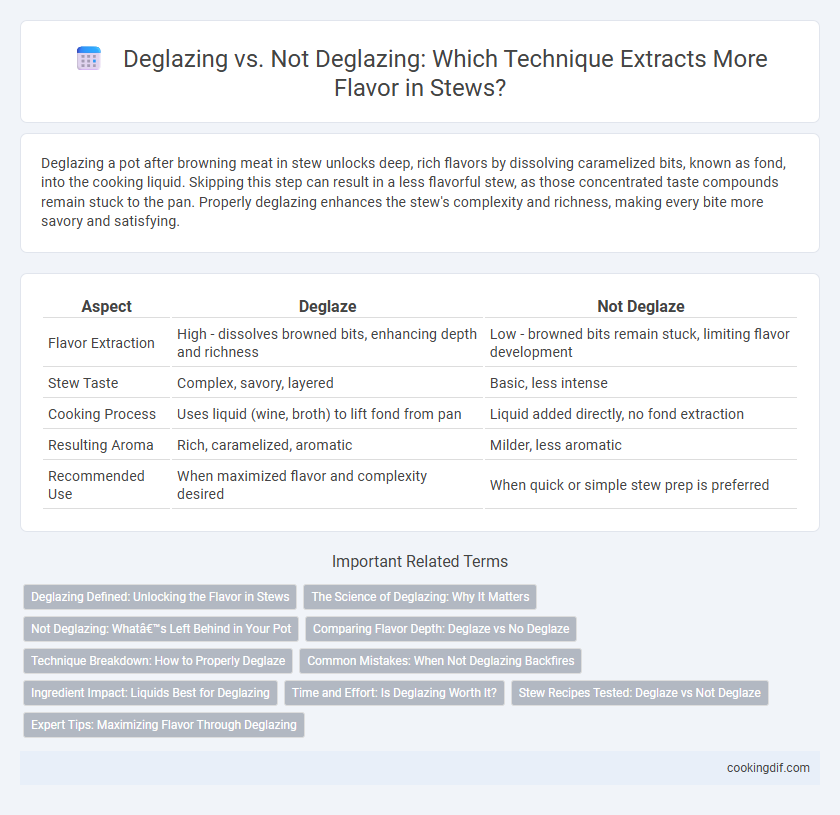Deglazing a pot after browning meat in stew unlocks deep, rich flavors by dissolving caramelized bits, known as fond, into the cooking liquid. Skipping this step can result in a less flavorful stew, as those concentrated taste compounds remain stuck to the pan. Properly deglazing enhances the stew's complexity and richness, making every bite more savory and satisfying.
Table of Comparison
| Aspect | Deglaze | Not Deglaze |
|---|---|---|
| Flavor Extraction | High - dissolves browned bits, enhancing depth and richness | Low - browned bits remain stuck, limiting flavor development |
| Stew Taste | Complex, savory, layered | Basic, less intense |
| Cooking Process | Uses liquid (wine, broth) to lift fond from pan | Liquid added directly, no fond extraction |
| Resulting Aroma | Rich, caramelized, aromatic | Milder, less aromatic |
| Recommended Use | When maximized flavor and complexity desired | When quick or simple stew prep is preferred |
Deglazing Defined: Unlocking the Flavor in Stews
Deglazing is the process of adding liquid, such as wine, broth, or stock, to a hot pan after browning meat or vegetables to dissolve the caramelized bits stuck to the bottom, known as fond. This technique unlocks intense, concentrated flavors that deepen the complexity and richness of stews. Skipping deglazing often results in a flatter, less flavorful stew, as the fond, which contains intensified taste compounds, remains unextracted.
The Science of Deglazing: Why It Matters
Deglazing involves adding liquid to a hot pan to dissolve browned food residues called fond, which are rich in complex flavor compounds formed through the Maillard reaction. This process releases umami-enhancing molecules like amino acids and sugars, significantly deepening the stew's savory taste. Skipping deglazing leaves these flavorful compounds stuck to the pan, resulting in a less intense and layered stew flavor profile.
Not Deglazing: What’s Left Behind in Your Pot
Not deglazing leaves browned bits, or fond, stuck to the pot, resulting in less flavorful stew as these caramelized flavors remain unused. The absence of liquid to lift these concentrated taste compounds means the stew may lack depth and richness. Consequently, the overall complexity and savory profile of the dish are diminished without the deglazing step.
Comparing Flavor Depth: Deglaze vs No Deglaze
Deglazing a stew enhances flavor depth by dissolving the caramelized fond stuck to the pan, releasing complex, savory compounds that enrich the broth. Without deglazing, the stew may lack this concentrated taste layer, resulting in a comparatively flatter, less robust flavor profile. The chemical interaction during deglazing intensifies umami and develops richness that cannot be achieved by simply adding liquid.
Technique Breakdown: How to Properly Deglaze
Deglazing enhances stew flavor by dissolving browned fond from the pan after sauteing meat or vegetables, incorporating deep umami-rich elements into the base. To deglaze properly, remove excess fat, pour a small amount of liquid--wine, broth, or water--into the hot pan, and scrape the bottom with a wooden spoon to lift caramelized bits. This technique intensifies the stew's complexity, creating a rich, balanced taste that contrasts sharply with stews where deglazing is skipped and flavors remain flatter.
Common Mistakes: When Not Deglazing Backfires
Neglecting to deglaze after browning meat in a stew often results in a loss of rich, caramelized flavors trapped in the pan's fond. Common mistakes include scraping off these browned bits prematurely or adding liquid too late, which prevents proper dissolution of savory compounds necessary for depth. Failing to deglaze can yield a flatter, less complex stew lacking the robust umami that elevates traditional recipes.
Ingredient Impact: Liquids Best for Deglazing
Deglazing a stew with liquids like red wine, beef broth, or balsamic vinegar enhances flavor extraction by dissolving browned bits from the pan, intensifying the dish's taste. Using water instead of flavorful liquids yields a less robust flavor profile, limiting the stew's depth and aroma. Choosing rich, acidic liquids maximizes ingredient impact by balancing the stew's savory and tangy notes.
Time and Effort: Is Deglazing Worth It?
Deglazing a stew by adding liquid to the hot pan and scraping up browned bits accelerates flavor extraction, intensifying the dish with minimal extra effort. Skipping deglazing saves a few minutes but results in a less complex, less rich flavor profile, often requiring longer cooking times to develop similar depth. For home cooks prioritizing robust taste with efficient use of a few additional minutes, deglazing proves a worthwhile technique for elevating stew flavor.
Stew Recipes Tested: Deglaze vs Not Deglaze
Stew recipes tested showed that deglazing the pan significantly enhances flavor extraction by capturing browned bits rich in umami, which infuse the broth with deeper complexity. Not deglazing leads to a reliably milder taste profile, often resulting in less robust and flatter flavors. Culinary tests confirm that deglazing with wine, stock, or water after searing protein elevates the stew's overall savory depth and mouthfeel.
Expert Tips: Maximizing Flavor Through Deglazing
Deglazing a pan after browning meat in stew enhances flavor by dissolving caramelized bits, known as fond, which contain intense, savory compounds crucial to depth and richness. Experts recommend using acidic liquids like wine, vinegar, or broth to lift these flavors, preventing bitterness and promoting a balanced taste profile. Skipping deglazing can result in a flat stew, as the browned residue remains stuck and unextracted, missing out on complex umami layers.
Deglaze vs Not Deglaze for Flavor Extraction Infographic

 cookingdif.com
cookingdif.com